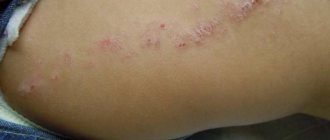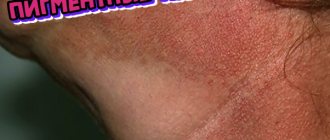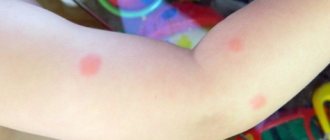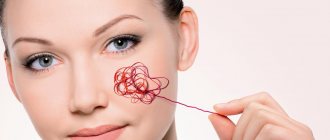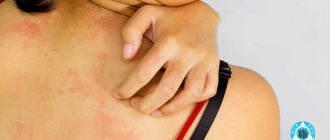Red dots on skin photo
Possible diseases
According to dermatologists, any rash on the skin indicates that the body contains harmful substances that it is trying in every possible way to expel. It is also worth noting that sometimes psychosomatic problems can cause the appearance of red spots.
If you are constantly in a state of stress and irritation, you should not be surprised at the appearance of a rash. This is a completely normal reaction of the body to negativity.
However, one should not discount the possibility of more serious diseases, for example:
- eczema and psoriasis;
- ringworm and urticaria;
- erythema and rubella;
- scarlet fever and dermatitis;
- diseases of the endocrine system (enlarged thyroid gland, Graves' disease);
- hyperpigmentation and disorders of the genitourinary system;
- rheumatic diseases and tumors.
As you can see, the list of possible diseases is quite extensive. Moreover, many of the diseases are accompanied by a number of additional symptoms.
Therefore, if you notice that small dots have formed not only on the stomach, but also on the hips or back, immediately contact a specialist.
Diseases of the liver and pancreas
Pathologies associated with insufficient excretion of bile from the body cause Tuzhilin syndrome. The condition is characterized by the appearance of small red dots on the body. These are vascular aneurysms of regular shape, located mainly on the chest, abdomen, and shoulders. If you press on them, they turn white for a while. In addition to the rash, yellowing of the skin and sclera of the eyes, nausea, vomiting, and bowel disorders are noted. Patients complain of abdominal pain. Treatment depends on the specific pathology, its form and severity.
Folk remedies
The use of folk recipes to get rid of red spots on the stomach should be carried out with great caution, because Without taking into account the reason for their appearance, you can not improve the condition, but harm the body.
Under no circumstances should you use methods that are aimed at eliminating red dots on your own (tearing off, removing, cauterizing, etc.)
The safest thing to do is to lighten the red dots to make them less noticeable. The easiest way is to alternately apply cotton swabs soaked in lemon and garlic juice. Onion, dandelion or pineapple juice will also help fade the redness of the spots. In any case, when turning to the advice of traditional healers, be extremely careful.
Helminthiasis
The source of worms can be poorly processed food and unboiled water. You can also become infected from another person or animal. You can also get helminths in nature and in public places. Skin rashes due to helminthic infestation are vascular in nature due to disruption of the biliary tract. An allergic reaction to the waste products of parasites also occurs. After worms enter the body, patients experience weakness, nausea, fever, and chills. Muscle pain and discomfort in the abdomen appear. There is indigestion and stool disorder. There is a burning and itching sensation in the anus. They fight parasites with anthelmintics and antibiotics. Digestion is restored by taking enterosorbents and probiotics.
Elimination methods
Self-diagnosis, compiling a history of the disease together with the attending physician, consultation with a competent specialist, laboratory tests - these are the actions that will most reliably help establish the true cause of the disease.
Red dots on the back, stomach, legs and other surfaces will disappear if treatment is correctly prescribed for the disease that caused these formations.
| Cause | Elimination method |
| Mechanical impact (epilation, microtrauma, etc.) | Use healing ointments or creams, and as a preventive measure, try to avoid injuries. If this is the result of hair removal, choose other shaving products and purchase effective cosmetics after this procedure. |
| Vitamin deficiency | Take complexes rich in essential vitamins. And also eating foods rich in those vitamins that the body lacks. |
| Hemangioma | Eliminate a benign tumor by contacting a doctor: laser, surgery, cauterization. The branches of hemangiomas are removed by tying off the branches and removing large trunks. |
| Liver diseases | Detoxification using medications prescribed by specialists. Therapeutic nutrition (excluding alcohol, salts, and excessive fluid intake from the diet), limiting physical activity, and controlling body weight are additional ways that have a beneficial effect on the process of getting rid of spots. |
| Gastrointestinal diseases | Diet, therapy aimed at relieving pain and regulating the normal functioning of the stomach, intestines, pancreas and other organs. |
| Rheumatoid problems | Drug treatment, physiotherapy, lifestyle changes. |
Bleeding disorder
Most often caused genetically. It occurs due to a deficiency of a special protein in the blood. This is common in patients with hemophilia and von Willebrand disease. The disorder can also be acquired. It is caused by taking non-steroidal anti-inflammatory drugs and hormonal drugs, liver disease and even childbirth. Patients experience the appearance of red dots on the skin in the form of bruises, bruises that appear for no reason, and uterine bleeding. Blood is also released from the nose, rectum, and gums. There is slow clotting after injuries and medical procedures. Patients require lifelong intravenous injections containing the missing protein.
Reasons for the appearance of dots
Formations of various sizes, colors and shapes often appear on human skin. In most cases, they do not pose a danger, since they are classified as moles. However, not all spots have a brownish tint.
If you notice that red spots have appeared in the abdominal area, there may be several reasons for this:
- tanning abuse;
- poor nutrition;
- hormonal imbalances;
- infectious diseases;
- parasitic diseases;
- stress and overwork;
- pregnancy;
- allergic reaction.
In addition, swollen pale pink dots can signal a disease of the internal organs. Therefore, the problem cannot be ignored under any circumstances. If you notice changes in the skin, be sure to consult a doctor for an accurate diagnosis.
Angiomas
Tumor nodules from overgrown vessels, resembling red moles in appearance. They can be localized on any part of the body. They most often appear in the upper torso, head and neck. When pressed, the spots turn pale for a moment and then return to their original color. In some cases, the growths may become inflamed and ulcerate. Damage to them can lead to severe bleeding. Pinpoint angiomas are removed with a laser, liquid nitrogen or electric current. If the spots grow quickly and occupy large areas, radiation or hormonal therapy will be needed. In cases where the nodules do not change size or cause discomfort, treatment is not required.
Small red dots on the body can be a sign of diseases of various organs and systems. A seemingly harmless defect sometimes turns into a serious pathology. If such rashes do not go away for a long time or appear again and again, you should consult a dermatologist. He will conduct the necessary research and, if necessary, refer you to a specialized specialist.
Infectious diseases
For the doctor, the nature of the spots, their location and appearance are of great importance. Often, one glance at a skin rash is enough for a specialist to suspect a particular disease. The nature of the spots will differ for mycotic, viral and bacterial infections.
Viral diseasesIn diseases such as measles, rubella and chickenpox, the appearance of spots on the skin is the first symptom of infection. In each case, isolation of the patient is necessary in order to prevent the development of a mass outbreak of a viral disease. That is why a timely examination by a doctor and making a correct diagnosis is so important. Characteristic features of rashes due to various viral infections:
In adulthood, chickenpox manifests itself with other symptoms. |
Diseases caused by bacteriaStreptococcus is more likely than other bacteria to cause spots on the skin. This dangerous microorganism causes diseases such as scarlet fever, erysipelas and streptoderma. The location of the spots and their nature are strictly specific for each bacterial infection. In addition, they all have additional features. For example, with scarlet fever, the rash is always accompanied by a sore throat. |
Fungal skin diseasesWith fungal infections, red spots often appear on the skin. Sometimes they accompany a disease such as candidiasis, which is widespread. If rashes appear on the skin with thrush, this indicates a generalized form of infection and indicates a deficiency of the patient’s immune system. Ringworm is accompanied by the appearance of red, scaly spots on the skin. The fungus affects the scalp, but it is possible that it can be found in other parts of the body. |
Related article: Pink and red spots (with photo)
Other skin changes
As a rule, these are symptoms of violations of certain liver functions as a result of liver disease.
Allergic dermatitis often occurs with liver diseases. A rash, as a symptom of dermatitis, appears due to a violation of the detoxification function of the liver. Skin manifestations of dermatitis vary, but most often these are bright red spots or plaques. Dermatitis usually occurs suddenly. Treatment of allergic dermatitis is complex.
There is often a tendency to develop pustular dermatitis in the form of typical rashes - folliculitis, furunculosis. This is a manifestation of immune imbalance in response to a decrease in the synthesis of immunoglobulins by the liver.
Atrophic stripes (striae or “stretch marks”) develop as a manifestation of secondary hormonal imbalance in liver disease. They are located on the thighs, buttocks, lower abdomen, and sometimes on the arms.
What is cirrhosis of the liver?
Cirrhosis is an incurable pathology in which the parenchyma is replaced by connective tissue. The mechanism of formation is associated with lipocytes, or Ito cells. Lipocytes exist in two states: quiet - they are responsible for storing vitamin A reserves, activated - they form scar tissue in damaged areas of the liver.
With constant exposure to viruses, alcohol, poisons, and toxins on the gland, Ito cells have to become more active. Areas of connective tissue grow, the parenchyma becomes islands with a fibrous surrounding. The blood supply to the organ is disrupted, the vessels have to be rebuilt, bypassing the affected areas.
With a decrease in the amount of healthy parenchyma, the gland ceases to cope with its functions. Hormones and toxins are not neutralized, enter the bloodstream and poison other organs. Varicose veins of internal organs appear. The functioning of the kidneys and brain is disrupted. The final stage of cirrhosis is fatal.
Liver cirrhosis develops over a long period of time and has four stages.
- Compensated. The damage is minor, the healthy part of the parenchyma copes with the functioning of the organ. Manifestations of the disease are invisible.
- Subcompensated. The defeat is massive. The load on the preserved part of the liver increases, and malfunctions begin. The first signs appear - dyspepsia, disruption of sleep and wakefulness, increased fatigue, decreased appetite, jaundice, weight loss.
- Decompensated. Connective tissue makes up most of the liver. The remaining healthy cells cannot cope with their functions. Decay products, not neutralized toxins, poisons, hormones poison the body.
- Terminal. Complete replacement of parenchyma with fibrous scars. The organ doesn't work. Numerous complications develop.
In the early stages of cirrhosis, external signs are not noticeable; they appear later, when the damage is significant:
- Pain in the right hypochondrium.
- Dyspeptic disorders.
- Itchy skin, worse at night.
- Disturbance in sleep and wakefulness.
- Yellowness of the skin, mucous membranes, sclera.
This is interesting: Hepatitis and cirrhosis of the liver: the same thing or not. What hepatitis leads to cirrhosis?
- Redness of the palms and soles of the feet.
- Abdominal enlargement due to weight loss.
- Gynecomastia in men, decreased libido.
- Spider veins on the body.
How to relieve symptoms?
Red spots on the body often itch. If their origin is associated with infection, then treatment must be carried out under the supervision of a doctor. Typically, such diseases occur in combination with respiratory symptoms and general intoxication of the body:
- increased body temperature;
- headache;
- pain and redness in the throat;
- weakness;
- loss of appetite.
If there are signs of infection, then you need to call a doctor at home. Medical attention is also required if the spots appear suppurated, difficulty breathing, swelling, blueness of the lips, skin or limbs, or fainting.
When a spotty rash of an allergic nature appears on the body, the first thing you need to do is identify the irritant. Sorbents will help cleanse the blood - Enterosgel, Polysorb, White Coal, Atoxil. You can relieve itching with antihistamines (Tavegil, Suprastin, Cetrin, Loratadine). Compresses based on decoctions of chamomile, oak bark, and sage soothe irritated skin well. For 1 glass of boiling water you will need 1 teaspoon. dry raw materials. There are also antipruritic agents for external use. These are Fenistil gel, Bepanten cream, hydrocortisone ointment.
What types of spider veins are there on the body?
Depending on the vessels undergoing pathological expansion, three types of asterisks, or telangiectasias, are distinguished:
- Capillary - inconspicuous, formed from small blood vessels.
- Venous - larger in size.
- Arterial - even larger, visible to the naked eye.
Asterisks in cirrhosis are red and blue. There are four types based on form:
- Spot. A dark dot surrounded by blue streaks of capillaries. Located on the legs. A significant amount is capable of forming spots.
- Tree-like. They look like a twig with branches, the color is blue, and are found in the thigh and lower leg area.
- Arachnids. They have a center, an arteriole, from which “spider legs” diverge - capillaries. Of red color.
- Linear. They look like parallel lines, of any color, favorite places of localization are the nose and cheeks.
Treatment
- If the spots occur due to damage to the skin, they will go away on their own if you do not get injured again and avoid traumatic situations.
- If you have hypovitaminosis, you need to take a course of vitamins prescribed by a specialist.
- The easiest way to remove a hemangioma is with X-rays, excision, or cauterization.
- Viral diseases are treated with medications prescribed by a doctor. It must be remembered that treatment must be started immediately so as not to lead to death.
- Diseases of internal organs also require proper therapy. In addition, the sick person must monitor their diet and lead a healthy lifestyle, giving up bad habits.
- If red dots occur due to rheumatoid diseases, treatment requires products without steroids, as well as physiotherapeutic agents.
If red dots appear, it is best to contact a therapist, who, after analyzing your condition, will refer you to the right specialist.
Hemangioma
Scarlet or burgundy dots, similar to moles, can be on a person’s body from birth or appear over the course of life. In the medical literature or on the Internet there is another name for this phenomenon - angioma. Doctors recognize them as benign, but do not exclude the possibility of them becoming malignant in the absence of proper care.
In newborns, hemangioma grows during the first year and quite often goes away by the age of five years. In adults, hemangioma rarely appears and is a consequence of lack of treatment in childhood. The development of this benign tumor occurs due to improper formation of blood vessels inside the womb. The formation of hemangioma can be promoted by:
- multiple pregnancy;
- birth injuries;
- smoking during pregnancy;
- intoxication;
- maternal age from 40 years;
- prematurity.
Painful red itchy spots
Itchy and painful red patches on the skin can be irritating, uncomfortable and worrying, especially if the person does not know what the underlying cause is. The rash can cause discomfort, burning and a constant urge to scratch the skin.
A common cause of these symptoms is cellulitis. This is a skin condition that occurs as a result of infection of the skin and soft tissue underneath. Cellulitis occurs when bacteria enters a break in the skin and spreads, which can lead to swelling, redness, pain and a feeling of warmth.
Erysipelas is an acute, febrile infectious disease caused by a specific streptococcus. This infection is characterized by deep red inflammation of the skin or mucous membranes, which can cause pain and itching.
Chickenpox, an acute infectious disease especially common among children, can also be a major cause of red and itchy, painful bumps and blisters on the skin.
Acne, which results from inflammation and infection of the sebaceous glands in the skin, is a possible cause of painful redness on the face and other parts of the body. Acne is most common in children.
